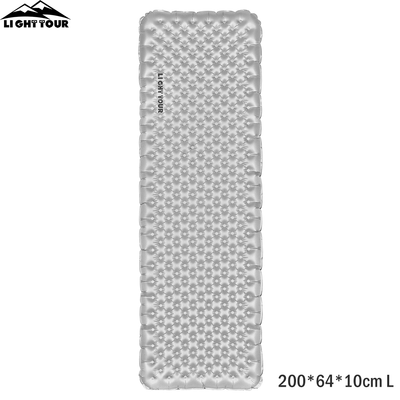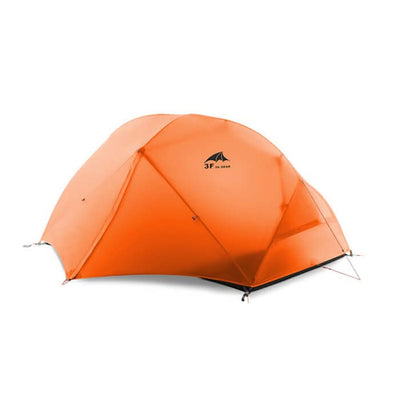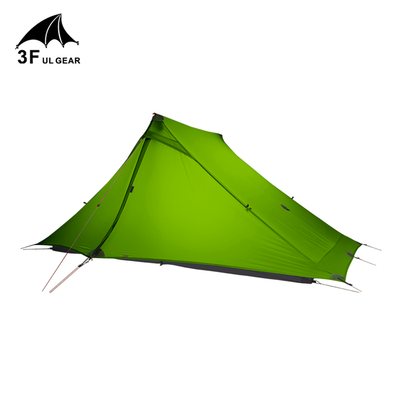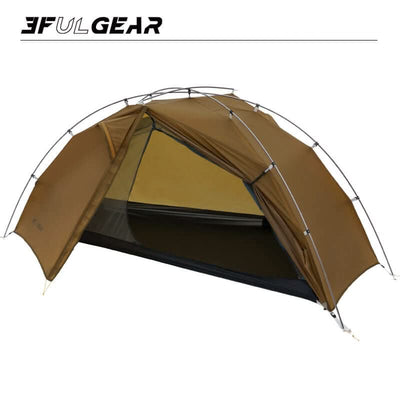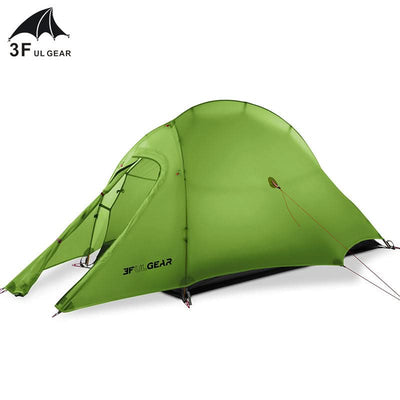How is buying a backpacking tent different from purchasing any other tent? A tent is a tent is a tent, right? Tents like cars, houses, and boats are not all the same. You need a tent that fits your needs, and if you are backpacking, your needs are different from the camper with a handy vehicle and spacious trunk. You still need shelter from the storm, warmth, and comfort, but you also need a tent that you can carry and set up quickly in unfamiliar terrain.
How to Choose a Backpacking Tent?
1. What Do You Need from a Backpacking Tent?
The precise answer to that question depends on your purpose in buying a backpacking tent. All backpackers are different, ranging from the casual backpacker who enjoys hiking through and enjoying nature to the ultralight endurance backpacker who wants to cover a long distance in challenging terrains as quickly as humanly possible.
The crucial factors in buying a backpacking tent include:
· Comfort – a minimum standard to give you a good night's sleep or more enjoyable interior space for the more relaxed backpacker.
· Weatherproofing – depends on the climate, season, and the location of your backpacking trip as you need to choose a backpacking tent that matches the expected conditions.
· Weight and pack size – you and your party need to carry all your equipment, and tent weight is a compromise between lightening your load and retaining livability features.
· Setting up – after you've spent a day walking and you are ready to take the weight off your feet, you don't want to struggle with putting up a complicated tent in the pouring rain and fading light.
· Durability – the nature of backpacking is that you set up the tent, take down the tent, repeat all through your trip. Your backpacking tent needs to be robust enough to survive the constant packing and unpacking as well as the weather.
· Budget – all purchases are a trade-off between quality and cost. Backpacking tent features of lightness, durability, and comfort are a trade-off with the price paid, with weight as a crucial factor. Heavy tents tend to be cheaper because they lack the high technology materials that make a backpacking tent lighter.
Understanding how you need your backpacking tent to perform for your expected use will give you a shopping list of crucial features enabling you to choose the best backpacking tent within your budget.
1.1 Budget
The tendency with a backpacking tent is to pay more for less – reduced weight, fewer poles, and ultra-light materials. The difference can be hundreds if not thousands of dollars. Brand name tents in the United States and Europe can start at several hundred dollars, with many people seeing $500 as the minimum spend.
Yet many of these high-priced tents are constructed here in China for much less. Buying your best backpacking tent from a company like China brands (3f, naturehike, mobi garden ) give you access to premium features at a low budget price of around $150, adding in the shipping costs, and you still come out with a massive saving on your budget.
Tents and Seasonality
The seasonality rating is a bit misleading. Spring in the temperate regions is different to spring in the mountains or the polar regions. A tent's seasonal rating tells you what weather it can withstand and how strong it is. A four-season tent is a winter or mountaineering tent, and it is always more robust than a three-season tent.
A four-season tent withstands high wind and heavy snow but is not as fresh and airy as a three-season tent intended for hot summers and chilly spring and fall.
The three-season tent is the base model, and most backpacking tents are three-season tents. Moving from three seasons to three plus and four-season tents bring changes to increase strength and weatherproofing.
You can expect a three-season tent to protect from light wind, rain, and the odd snow flurry that you expect in the summer months in temperate climates if you pitch the tent correctly with tension in the fabric.
Typical features include:
· Mesh panels that allow air in and keep insects out.
· Weight is kept low by having a minimum number of poles and using light fabric.
· More vertical walls give a more comfortable interior.
Three-Season Plus or Three to Four-Season Tents
These backpacking tents fit between the summer and the winter tents. You expect them to be stronger and more weatherproof but not quite to the four-season tent's mountaineering standard. You can see these backpacking tents as extended season tents in some listings. Differences from the three-season tent include:
· Protective rainfly panels that zip into place over the mesh panels giving you the option of air or weatherproofing.
· One or two more poles to increase structural strength.
· Slightly heavier material, although high-technology fabrics can be light and weatherproof.
Four Season or Mountaineering Tent
For weatherproofing and the ability to keep you warm and dry in the worst conditions that nature can throw at you, you need a four-season backpacking tent. A bit heavier than the three-season, but when a blizzard picks up and you need to hunker down for several hours, you will be glad of your foresight in choosing this backpacking tent for your adventure.
Differences from the lighter tents include:
· More poles – the poles give your tent stability and strength.
· Domed shape instead of vertical walls – the wind passes smoothly over without catching and tearing, and the curves don't allow snow to build up on flat panels.
· Rainfly extends to the ground – maximum weatherproofing for all-round protection.
· Few if any mesh panels and zipped fly sheet protection keeps out drifting snow and driving rain if necessary.
1.2. Capacity, Comfort, and Livability
Backpacking tents come in one, two, three, and four people sizes. There is no industry standard, so the number of people your backpacking tent can fit inside is the manufacturer's assessment of how many people can sleep inside the tent. Comparing backpacking tents for capacity and comfort means taking account of the tent shape and measurements.
Assessing how comfortable a backpacking tent requires an assessment of many factors:
· Tent shape – sloping sides reduce the useable portion of the floor area, handy for gear, and you can sleep with your feet and head in these restricted areas. Tents with sloping sides are lighter than tents with vertical walls but less spacious.
· Peak height is always given at the maximum point and indicates how easy it is to sit up in the tent. A better indication is the pitch -how much headroom you have in other parts of the tent, but you need to examine the tent's diagrams to assess that.
· The floor's dimensions and the area indicate the space inside, but not all that space is useable. When comparing one tent with another, try and assess how much of that floor space is useful.
· Rainfly color – a brightly colored exterior makes it easy to spot your tent at a distance, but it benefits the interior. Bright colors reflect light inside the tent and give you a feeling of spaciousness lost with a heavy dark tent. A brightly colored rainfly does not increase the interior dimensions, but it makes you feel better about them. You relax and feel less shut-in or claustrophobic.
· Doors – these let you get in and out of the tent. An entry for each person means you don't clamber over each other to get out, but a single door is lighter (only one set of zips for a start).
· Ventilation – the human body generates moisture, and without ventilation, this condenses inside the tent. Mesh panels and roof vents all provide ventilation. Protective panels and flaps can weatherproof these when keeping water out is more essential than airing the tent. Doors that roll up or tie back are useful for airing a backpacking tent before you pack it for your day's travel.
Generally, adding in an extra person for your gear and additional space is an excellent rule, but it increases the tent's weight. However, if you are carrying the tent across several party members, the bonus of more room inside the tent is worth a few extra ounces. The ultimate decider is the weathering the storm test – if you had to spend a day inside this tent waiting out bad weather, would you be comfortable?
1.3 Weighty Matters
The weight of the tent comes from the material, poles, guy ropes, and stakes. The tent is often split into components and divided around the backpacking team, so no one carries the whole tent. When you choose a backpacking tent, you see different weights in the description:
· Minimum trail weight covers the tent poles and the tent fabric, but not the packing sack or the stakes and guy ropes.
· Pack weight covers the tent's weight when the supplier ships it to you, and it includes everything from the packing materials to the instructions.
Keeping the weight down is a compromise between durability, stability, weatherproofing, and comfort. An ultralight backpacker can strip their tent down to a light rainfly, a few stakes, and guy ropes and use trekking poles instead of tent poles. But a less radical approach is to allow for some home comforts and better protection from the elements.
You can get ultralight tents under 2lb in weight or a budget tent weighing substantially more at 5-6lbs. But you can get a high-quality backpacking tent in the 3-4lb weight range that provides a reasonable level of comfort.
When choosing a backpacking tent and comparing the tent's weight, make sure you compare the features because you may prefer to carry a few ounces more to have a more rigid tent or even an extra door.
1.4 Backpacking Tent Construction
A tent is a construction of poles (rigidity and structure) and material (weatherproofing and privacy) with accessories like guy ropes and stakes to keep the tent in place and put some tension on the fabric. A taut fabric encourages water to run off and creates a more stable tent.
The double-walled tent is a typical construction:
· Poles – lightweight and strong aluminum.
· Inner canopy (usually light mesh) with a sewn-in tent floor of heavier waterproof material.
· A waterproof and windproof rainfly goes over the top and stakes down.
Although slightly heavier, these backpacking tents are straightforward to pitch, and the typical shapes are:
· Freestanding – you erect the tent, and then you can pick it up and move it to your preferred location. The poles and fabric create the tent shape, and these backpacking tents are robust and stable.
· Semi-freestanding – fewer poles, and you need the guy ropes and stakes to create the tent shape. These backpacking tent styles are lighter because you have fewer poles, but you lose a bit of stability.
· Tunnels – hoop-shaped poles create a tunnel shape. You need the guy ropes to keep everything in place, but these backpacking tents are roomy and comfortable.
Four-season tents tend to be single-walled with a heavy-duty rainfly.
Some backpacking tents give you the option to pitch the tent only using the rainfly and substituting trekking poles for tent poles. There are ultralight or minimal backpacking tents that suit people who want to go far and travel faster and don't mind rough camping:
· Tarp tents – a square rainfly that you use to create a shelter or awning. These are the favorite wilderness survival types because they are versatile in use, from a standard A-frame shelter to an overhead awning. A more elaborate tarp tent uses a pyramid shape with some poles. These pack to a super-small package.
· Hammock tent – tarp-like rain protection and bug netting, designed for suspension.
· Bivy sack – waterproof breathable sack to enclose you and your sleeping bag. Sometimes with poles to create a roomy headspace.
· Bug shelter – netting and some poles, can be more elaborate.
The shape, weight, and quantity of backpacking tent that suit you, depends on your approach to backpacking.
Material Matters
Most backpacking tents use a coated polyester for the waterproof rainfly and tent floor. High-performance tents may use the more expensive cuben fiber (tradename Dyneema).
PU Coated Fabric
PU is a coating of polyurethane to nylon or polyester, turning the fabric from water-resistant to waterproof. It is an economical way of creating a waterproof material that meets fire retardant standards for outdoor use.
There are some disadvantages to a PU coating:
· Decreased tear strength because it gets between the nylon fibers and makes it easier to break one thread at a time.
· Hydrophilic – PU coatings absorb water (very slowly) and can become waterlogged – you must dry your tent thoroughly to avoid mildew and mold, before storing.
· Poor hydrolytic stability – the PU coating reacts with moisture and heat to break down chemically, losing its ability to waterproof your tent. This chemical reaction creates an odor reminiscent of sweaty clothing and indicates your tent is reaching the end of its life.
SIL/PU Coated Fabric
The inside of the rain fly has a PU coating, and the outside a silicone coating. You get the benefits of both types of coating but also the disadvantages associated with each. The combination of silicone on one side of the fabric and PU on the other is a difficult balancing act to ensure full adherence to the fabric.
PE Coated Fabric
Polyether Urethane (PE) is less common than PU in backpacking tent materials because it is more expensive and heavier. They are durable and waterproof, and you find them on tent floors in expedition tents where waterproofing is sufficiently important to outweigh concerns about weight. This coating drastically reduces tear strength, so it is only suitable for heavy-duty fabrics with excellent underlying tear strength.
A PE coated fabric has excellent resistance to hot, humid climates (unlike PU coatings) and mixes easily with fire retardants.
Silicone Coating or SiNylon
Silicone is an inorganic polymer and is less prone to chemical reactions like hydrolysis. Plus, silicone is hydrophobic and does not soak up water giving the benefits of:
· Tent fabric remaining taut and not sagging in wet conditions.
· Easy to dry the rainfly by shaking off the water droplets.
· Excellent resistance to mold and mildew.
· Does not break down with the action of heat and water.
· Increases the tear strength of the fabric.
· Slippery surface lets snow slide off as well as rain.
The disadvantages of using a silicone coating are:
· Expense – about 10-30% more than PU coatings, but you get super longevity.
· Can't seam tape – premium factories use double-needled lap felled sewing to reduce this issue.
· Can't mix it with fire-retardants – a small number of States in America insist on the use of fire retardants on their tent fabric.
Dyneema Composite Fabric (formerly Cuben Fiber)
Dyneema is a brand that name for a fabric that is a laminate of ultra high molecular polyethylene threads between layers of a Mylar-like film. The Dyneema threads are not woven but lie at ninety-degree angles.
This high-tech fabric is:
· Extremely strong (better than Kevlar or steel) and extremely light.
· Same tear strength as nylon but weighs much less.
· Does not stretch – no need to tighten the guy ropes after you've pitched your tent.
· Waterproof and does not absorb water.
· Excellent UV resistance compared with nylon.
The downsides are:
· Expensive compared with traditional tent materials.
· Lacks abrasion resistance.
· Poor adhesion for seam sealing.
Backpacking Tent Poles
Most backpacking tent poles are lightweight but strong aluminum. Some carbon fiber poles are making an appearance, but these have the disadvantage of snapping with no warning under pressure. An aluminum pole will bend under severe pressure, and although that is not ideal, you still have a functioning pole for your tent while in the field.
2. Pitching Your Backpacking Tent
Don't underestimate the value of a backpacking tent that is straightforward to put up and take down. After a long day's hiking, you don't need a complex mathematical puzzle to solve before you can get a restful night's sleep.
It makes sense to practice putting your tent up and down before taking it on your first backpacking trip. First, you can check that it is complete and not damaged, and secondly, it helps build the knowledge of how the tent goes together.
Helpful features for ease of setting up include:
· Pole hubs – your poles unfold into a recognizable tent skeleton with perhaps a few cross poles for strength.
· Pole clips – these ate quick ways to attach the fabric to the poles and aid ventilation and diminish condensation. Pole sleeves are stronger but tricky and time consuming to fit the poles into the sleeves.
· Color-coded poles – these just make life easier as it is obvious what goes where.
· Freestanding tents tend to be quicker to erect and locate.
3. In the end, how to Choose Your Backpacking tent in Camperlists?
Make a list of what is most important to you in terms of capacity, comfort, weatherproofing, portability, and ease of use. Then browse our excellent range of backpacking tents and see how much more you can get for less by buying your gear from the heart of the Chinese outdoor industry.


